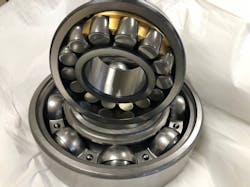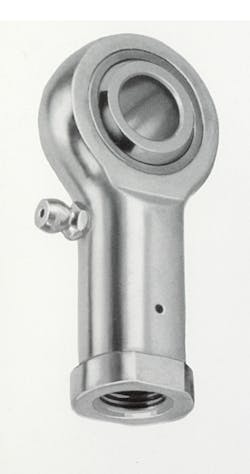It would be very easy to take ball and roller bearings for granted. They are capable of taking loads at high speeds in a variety of applications and have a service life of thousands of hours. These factors have continued to improve steadily with the development of improved steels, manufacturing techniques and strict quality control in the production process. In fact, currently less than one percent (.035) of bearings do not reach their expected life.
However, when a failure does occur, it is usually going to have dramatic results and should be addressed promptly and with an eye to evaluating why it happened and how to correct it.
In the past, the obvious culprits were few in number, including improper lubrication, mounting and installation techniques, poor bearing selection and environmental issues.
Increasingly, there is a new issue that is causing premature bearing failure. Many AC and DC motors with variable frequency drives (VFD) produce induced voltage on the motor shaft. The electrical charges seek the path of least resistance to ground, which is typically through the motor bearings. When current passes through the bearings, electrical arcs take place, which can lead to fluting, pitting and bearing damage which leads to bearing failure and costly downtime.
There are, however, two solutions that have grown in use.
Ceramic Hybrid Bearings
Ceramic hybrid bearings are dimensionally drop-in replacements for standard bearings and differ only in that they use ceramic rolling elements. Not only do they prevent a current from running through the bearing, they also have a lower coefficient of friction, allowing for higher speeds, output and longer bearing life. Fortunately, as ceramic bearings have increased in use, the costs have come down significantly.
Shaft Grounding Devices
While most bearings reach their expected life, it is helpful to attempt to evaluate why a bearing may have failed prematurely. When looking at a failed bearing, it is possible to see the end result of the problem, whether it be flaking, pitting, spalling, unusual wear patterns or rust and corrosion. These issues can usually be attributed to a small number of causes that are usually interrelated and correctable.
Lubrication
Proper lubrication is required to cover the rolling and sliding elements to avoid direct metal to metal contact. When done effectively, lubrication reduces friction and abrasion, reduces heat generated by friction, prevents rust and corrosion, and prolongs service life.
Grease is most commonly used for lubrication as it simplifies the sealing system, while oil is best suited for high speed and high temperature application. It is always important to have an understanding of the compatibility of the greases being used and an understanding that over-greasing, inducing churning, can be more problematic than using too little grease. As a general rule, you want to fill one-third of the bearing cavity with grease for proper lubrication.
We often refer to the service life of a bearing, forgetting that grease has a service life as well. Grease service life is defined as the time over which proper bearing function is sustained by a particular quantity and category of grease. Bearing failure often occurs when the expected life of the bearing and the grease are not matched well. This is especially critical in pump, compressor and motor applications.
Mounting and Installation of Bearings
The most straightforward application can be derailed if attention isn’t paid to the mounting and installation process. It is essential to pay attention to:
• The shaft and housing tolerances. If the fit is too tight, it will create too much preload; if the fit is too loose, it will create too little preload, which may allow the shaft to rotate or creep.
• Radial Internal Clearance (RIC). It is critical to maintain the original RIC that was established in the original design. The bearing, in most cases, is marked with the clearance which is on a scale in ascending clearance: C2, C0, C3, C4, C5. The proper internal clearance is critical as it allows for several challenges:
■ Heat. In the normal operation of a bearing there is heat that is produced that creates thermal expansion of the inner and outer rings. This can reduce the internal clearance and lead to seizing and failure.
■ Shaft fit. When the bearing is press fit onto the shaft there is an inevitable reduction in the internal clearance which has to be accounted for.
■ Lubrication. For realizing expected bearing life, a proper film of lubricant has to be established between the rolling elements. A reduced internal clearance reduced lubricant flow can lead to premature failure.
• Use of proper tools and ovens/induction heaters. Always use a sleeve to impact the entire inner ring face or the ring being press on to the shaft.
• Shaft deflection or misalignment. Avoiding this is especially critical when mounting bearings that have separable components, such as cylindrical roller bearings.
Operational Awareness
While the majority of bearings are properly designed for their application, it is important to be aware of signs that something has changed. Typically, these can be a change in the load factor, which can cause overloading and early fatigue, or too little load, which can cause skidding and early failure.
The first signs of these issues will be unusual noises and/or increased temperatures.
• Noises – There are typical abnormal bearing sounds that indicate certain issues in the bearing application. These can range from a screech or howl associated with too large an internal clearance to poor lubrication to crunching sounds indicating contamination.
• Increased temperature – Bearing temperature generally rises with start-up and stabilizes at a temperature slightly lower than start up. A desirable bearing temperature is below 100°C.
Operating Environment Can Influence Bearing Life
Problems with the operating environment can overcome the best design. These include:
• Dust and dirt, which can contaminate a bearing and challenge the best of sealing techniques.
• External heat. The ambient operating temperature should be a determining factor in choosing radial internal clearance, choice of lubricant and operating speed and load.
• Aggressive water or media. Sealing is primary. Has the use of specialty seals been evaluated? On radial bearings and mounted units, triple lip seals should be used while external pump/mechanical or labyrinth seals are recommended.
Current Passage
As noted above, there is increased bearing failure due to VFD use and induced shaft voltage. This can be a quick and easy remedy to a problem that is easy to overlook. In evaluating why a bearing may have failed, it can be helpful to look at the appearance of the internal surfaces of the failed bearing. This can often indicate obvious issues such as poor fits, excessive loading, shock loads, electrical currents, contamination, etc.
Premature bearing failure is an issue of importance at many levels. Thankfully, operational efficiency can be increased significantly with an awareness of these basic issues. WW
About the Author
Steven Katz
Steven Katz is the president of Emerson Bearing, a leading provider of bearings to OEM and MRO markets in the U.S. and internationally.


